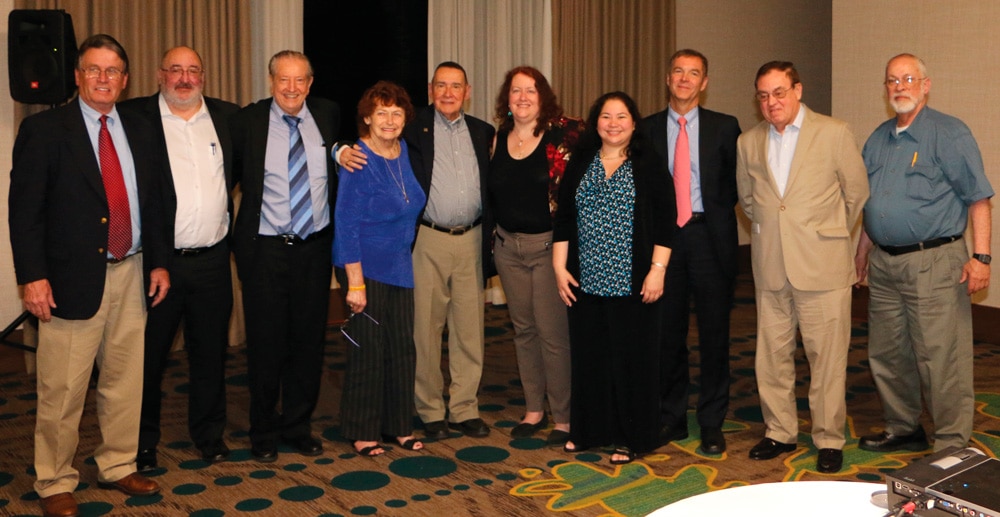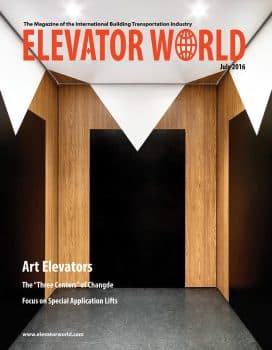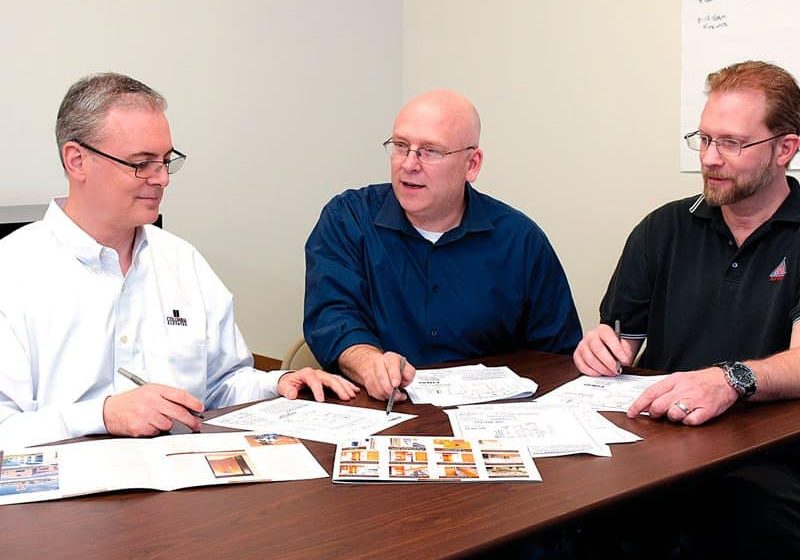“King George”
Jul 1, 2016

George W. Gibson receives a fitting tribute upon his retirement from the A17 Standards Committee.
It is fitting that George W. Gibson shared his retirement from the ASME A17 Standards Committee with many longtime friends and colleagues at a dinner held in his honor at the Hilton Palm Springs in Palm Springs, California, on May 3, part of A17 Elevator Code Week (see sidebar). Gibson is the longest standing member of the committee, having first been elected in 1975.
Several of Gibson’s close associates recognized his contributions to the industry, which he has been part of for 60 years. He started his career with Otis in 1956, holding positions of increasing responsibility until his retirement in 1993 as director of Worldwide Codes and Safety.
While at Otis, Gibson made many important contributions in engineering, codes and standards. Davis Turner recalled that his father, at the time Otis’ vice president of Construction, praised Gibson as “one smart kid” years before Turner and Gibson met. Needless to say, they ended up becoming fast friends. After retiring from Otis, Gibson became president of George W. Gibson and Associates, Inc., an elevator consulting firm he founded.
Hank E. Peelle, III, committee chair, spoke of Gibson’s agile mind, exquisite engineering skills, encyclopedic knowledge and ability to make the complex simple and, when necessary, the simple complex, both in committee work and on the witness stand.
Turner acknowledged Gibson’s encouragement and guidance when Turner started his own consulting practice. Gibson was not only a mentor but a trusted friend, Turner observed, acknowledging the many awards Gibson received over the years. He amused the crowd with stories about some of the other awards bestowed on Gibson, finally presenting him with the “Big Dog Emeritus” certificate in honor of his longstanding membership in the committee.
Your author followed with a lighthearted roast/toast slideshow. The last slide depicted Gibson as “King George,” a status that will always allow him to fulfill his Golden Rule: “He who has the gold makes the rules!”
Switching gears to a more serious message, your author acknowledged “King George” as an inspirational leader, mentor and teacher. Gibson was director of Worldwide Codes and Safety at Otis when he involved your author in A17 and International Organization for Standardization (ISO) code committees in 1987, encouraging your author to make codes and standards his career. Your author, who succeeded Gibson at Otis, concluded by thanking Gibson on behalf of the ASME Board on Safety Codes and Standards, as well as his friends involved in the Mechanical Design Committee, U.S. Technical Advisory Group (TAG) and ISO TC 178.
Patricia Reddington, director of ASME Safety Codes and Standards, said that, faced with a challenging situation, Gibson always willingly took action, thus inspiring others to do so. She acknowledged the contributions Gibson has made at multiple levels in ASME and to the industry as a whole. She concluded with the following quotes from notable authors:
“We often take for granted the very things that most deserve our gratitude.” — Cynthia Ozick
“Volunteers don’t get paid, not because they’re worthless, but because they’re priceless.” — Sherry Anderson
“I can no other answer make, but, thanks, thanks, and thanks!” — William Shakespeare
As a final gesture, on behalf of the ASME Council on Standards and Certification, Reddington presented Gibson with a certificate of appreciation for his contributions.
Hank E. Peelle, III, committee chair, spoke of Gibson’s agile mind, exquisite engineering skills, encyclopedic knowledge and ability to make the complex simple and, when necessary, the simple complex, both in committee work and on the witness stand.
Peelle identified the 15 ASME committees Gibson has been a member of and named the six he chaired: Mechanical Design, Earthquake, International Standards (U.S. TAG to ISO TC 178), Uncontrolled Car Motion, Elevator Stopping and Door Protection. He added that Gibson is a founding member of the QEI program. Peelle commended Gibson for his service to the industry with many entities outside of ASME, including the National Elevator Industry, Inc. (NEII®), NAESA International, National Fire Protection Association, International Association of Elevator Consultants, International Association of Elevator Engineers, Elevator Escalator Safety Foundation and Elevator World, Inc.
Peelle also noted that Gibson has written many technical articles, given numerous talks on elevators and has been awarded various patents. He further mentioned that Gibson is an ASME fellow and the recipient of many awards, including the ASME Safety Codes and Standards Medal, the Board of Governors Certificate of Award and the ASME Dedicated Service Award. Gibson also received a citation from the U.S. President’s Committee for the Handicapped in recognition of a wheelchair lift he designed in 1966.
Peelle observed it is a little daunting to pay respects to someone who has contributed so much, concluding with the following:
“A great analysis is not enough to make a difference. You were one of the best and most effective advocates for Otis, for ASME and for the industry. But, we are not alone in this world. Whatever is accomplished is through and with others. George, what makes you stand out from all those who went before you and to follow was your deep desire to work with others — either leading or participating — to make this a better and safer world.
“I realize that a George Gibson may only come around once in a generation, and I am honored that I was around when you were here. Truly, you are one of the few who has made A17 the standard of excellence it is today. Know this: you leave behind large footprints for those engineers who follow who also want to work with others to change the world.”
Richard Gregory, committee vice chair, presented Gibson with two items. The first was a framed “Big Dog Retiring” Award, which featured a picture of a contented dog and the inscription, “I think I will retire from the big dog table.” The second was a memento featuring a genuine 1920s Type 1-SOB Otis hall call inscribed with Gibson’s initials.
Geraldine Burdeshaw, committee staff secretary, presented Gibson with a framed honorary membership certificate. She explained the award represents the deep appreciation of Gibson’s peers, and ASME as a whole, for selfless service.
Gibson then delivered an eloquent and moving impromptu speech. He indicated he prefers to acknowledge the efforts of others, rather than receive acknowledgment. He thanked Turner and your author for organizing the event, going on to thank all the presenters for their kind words and gifts. He thanked his colleagues for the privilege of working with them and reassured everyone that he will continue to participate at a committee level for as long as he can.
Fittingly, upon completion of his address, Gibson received a resounding standing ovation from colleagues and friends.
A17 Elevator Code Week
Elevator professionals made progress on issues such as private-residence elevators (PREs) and protecting passengers and goods from elevator doors during the American Society of Mechanical Engineers (ASME) A17 Elevator Code Week at the Hilton Palm Springs at the foot of the San Jacinto Mountains on May 2-5. They also honored George W. Gibson upon his retirement after more than 40 years.
Approximately 150 people attended. Working committees focused on:
- Mechanical design
- Limited-use/limited-application elevators
- Protecting passengers and goods from elevator doors
- PREs
- Mine elevators
- A17 QEI requirements
- A17.4 Guide for Emergency Personnel
- Electrical inspections
- A17 standards
- New technology
- A17 international standards
- A18 standards
The Door Protection Committee has been through several chairs over the years. During this meeting, it was chaired by Louis Bialy. Protection of closing freight-elevator doors was worked out and codified some time ago, but the remaining (and more complex) issue covered was passenger elevators. The committee consisted of elevator professionals and representatives of various manufacturers of door-reopening devices such as multibeam infrared systems. The committee has a new ballot, which it will send out for review and comment. That is projected to generate more input as the effort moves forward.
The PRE committee welcomed a representative from the Consumer Product Safety Commission (CPSC), which has been asked to take action due to injuries and fatalities involving PREs. Most of these accidents are attributable to the clearance between the swing hoistway (hall) door and the (accordion and, to a lesser extent, scissor style) car gate. CPSC’s action could be total regulation of PREs. CPSC informed the committee that the organization prefers to order compliance with a voluntary standard if a good one exists.
ASME fully cooperated with CPSC. As it turns out, the approved changes to the PRE section of A17.1-2016, most likely to be published in October 2016, address these concerns. The CPSC plans to meet in October, so it’s a race to see what is done by when.
It is your author’s opinion that what the PRE committee has written for ASME A17.1-2016, Section 5.3 (covering PREs) is an amazing step forward and will satisfy and make CPSC happy. CPSC has limited resources, and it would take years for the commission to write regulations addressing PREs. CPSC believes it is much simpler to mandate compliance with ASME.
The Standards Committee was chaired by Hank E. Peelle, III, with your author and Cal Rogler as vice chairs. There were 34 requests for interpretations of the code. Some requests still need answers generated by working committees, and they were sent back to the inquirers after being deemed unclear. Some were simply closed. Where the committee generated responses, these responses were debated, modified and adopted for publication in the next book of interpretations. Technical revisions and procedures were discussed, and reports were received from the ad hoc, administrative, working and standards-writing committees.
ASME Staff Secretary Geraldine Burdeshaw conducted committee training, including sessions on copyright issues. During the Executive Session, membership of many people on various working committees was renewed. The next meetings are planned on September 26 in Atlanta and January 9, 2017, in Clearwater Beach, Florida.
Get more of Elevator World. Sign up for our free e-newsletter.








